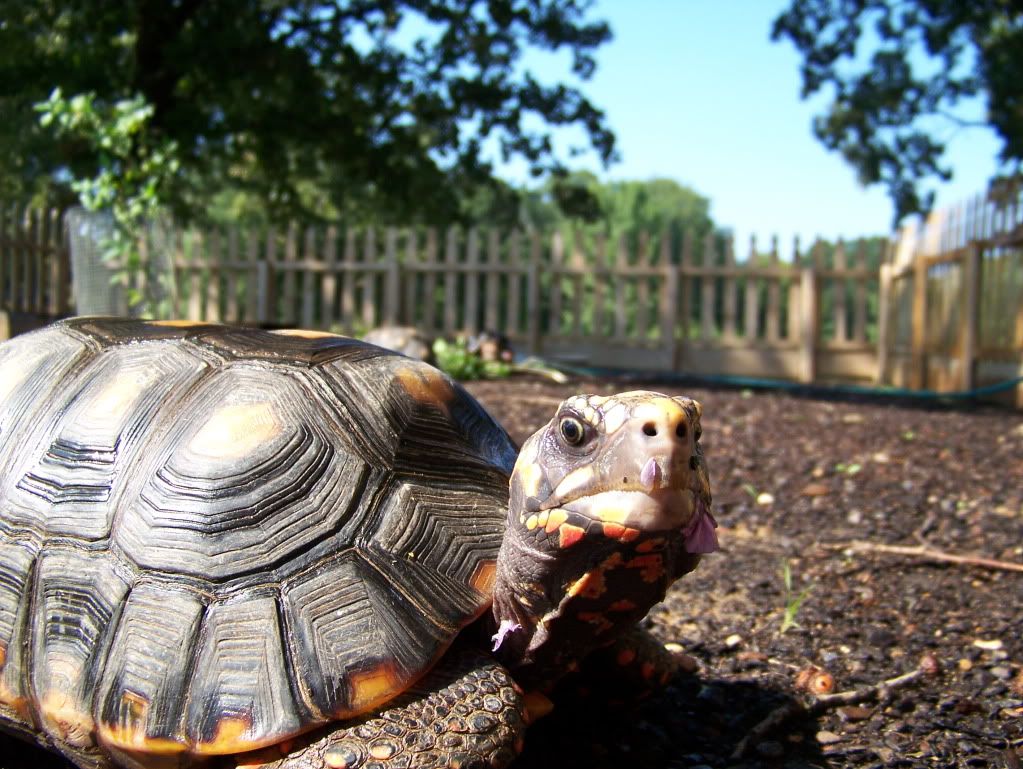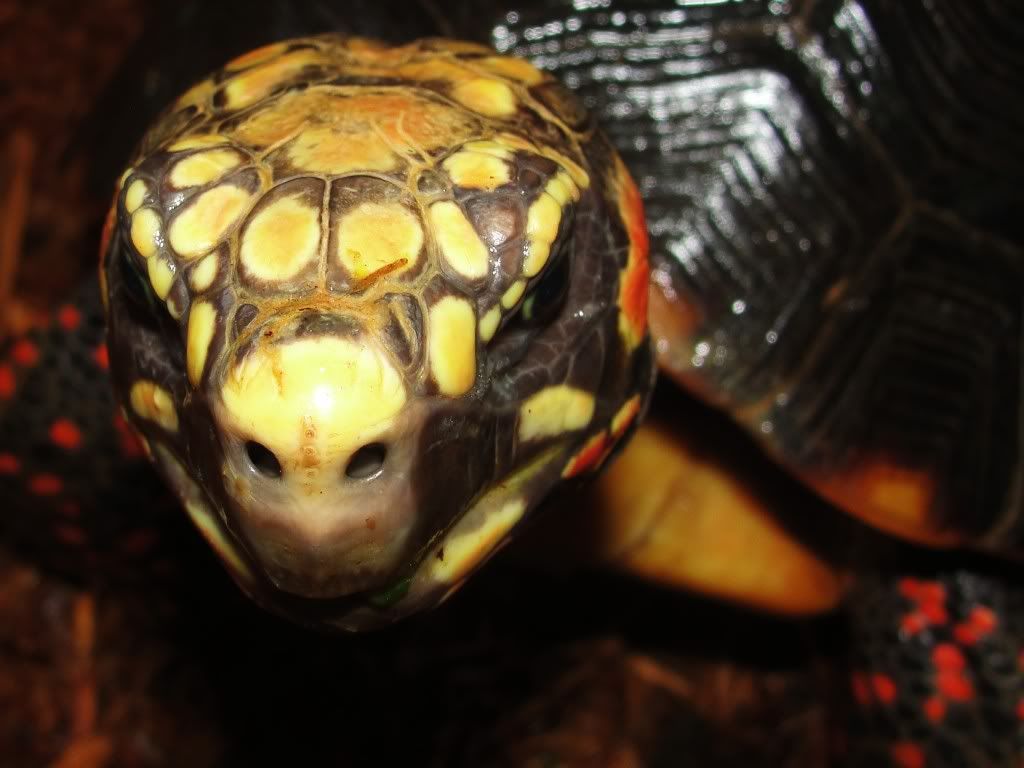Thats where Im having my troubles..... Up in canada even just a northern can be hard to find..... cherryheads are almost impossible.... So Im thinking Im finding mixes? I didnt know they could cross breed??? and what would they look like?
You are using an out of date browser. It may not display this or other websites correctly.
You should upgrade or use an alternative browser.
You should upgrade or use an alternative browser.
The Different Races of Redfoot Tortoise
- Thread starter Madkins007
- Start date
- Status
- Not open for further replies.
If this works, here is a range map of the groups I made up using the best info I can find...

If it does not work, here is a link: http://www.tortoiselibrary.com/range.html

If it does not work, here is a link: http://www.tortoiselibrary.com/range.html
Someone correct me if I'm wrong, but I don't think tortoises have hemipenis. They just have penis. And sometimes a female will show a bit of something out the cloaca too. Just sayin'
http://www.youtube.com/watch?v=0jA7m7QEo2s&NR
Graphic penile video..... Ok.... I did not see a hemipiene lol
Graphic penile video..... Ok.... I did not see a hemipiene lol
yeah turtles and tortoises have penises snakes and lizards have hemispienes (two penises)
2 new ones that were sold as "not northern" but who knows....
The bigger one is like a bowling ball, dark skin with no spots, has the big red scales in the arm pits and a neat design onb the bottom of her shell.... but no red head?


the smaller one just has neat markings on her bottom but the rest seems pretty normal. The crack is getting fixed
Any Ideas where they may be from?

The bigger one is like a bowling ball, dark skin with no spots, has the big red scales in the arm pits and a neat design onb the bottom of her shell.... but no red head?


the smaller one just has neat markings on her bottom but the rest seems pretty normal. The crack is getting fixed
Any Ideas where they may be from?

Top one is certainly a Northern, and I am pretty sure the bottom one is too. Probably pretty typical North-easterns, which are one of the more common in the pet trade.
So northerns can get round like a ball and have the big arm pit scales? there are so many variations and traits i cant keep track lol
I don't see the elbow spur in the above photos, and females are more 'bowl shaped' than the males are. There are some photos and info at
- http://tortoiselibrary.com/races.html or
- http://tortoiselibrary.com/cherryhead.html
- http://tortoiselibrary.com/races.html or
- http://tortoiselibrary.com/cherryhead.html
If I had to venture a guess,I'd say Venezuelan for both.
Its no problem mate, Im still getting the hang of this  Up here there were only northerns and this new type called brazilian cherryheads lol.... Were behind a few years up here lol.
Up here there were only northerns and this new type called brazilian cherryheads lol.... Were behind a few years up here lol.
She has the large red triangle scales that only my 2 cherryheads have. All my northerns have nothing similar. and the clear cut markings are throwing me off as all my others are more blotched?


She has the large red triangle scales that only my 2 cherryheads have. All my northerns have nothing similar. and the clear cut markings are throwing me off as all my others are more blotched?


Im just trying to be thourough in the future enclosures and breeds or races or subs or whatever they would be called.... I dont want to cross breed... and I have to start shopping for diffrent kinds of males (next to impossible up here) so i would love to know what im working with before i start building my battle plans 
And you guys in the states seem to have all the breeds at your disposal and all the Info first hand..... All I can do is search here LOL
And you guys in the states seem to have all the breeds at your disposal and all the Info first hand..... All I can do is search here LOL
Ha! Only the Northeastern (Guyana, Suriname, etc.) type and Eastern (Brazilian, 'cherry-head') are commonly available here. We almost never see the Northwestern (Panamanian), or Southern (Gran Chaco), and rarely see any from Colombia.
As far as DNA shows, all of the color phases of Northeasterns are the same type of tortoise.
As far as DNA shows, all of the color phases of Northeasterns are the same type of tortoise.
So where would a northern pick up the triangle scales in the armpits lol  Or the distinct triangle patterns on the belly?
Or the distinct triangle patterns on the belly?
From what I've been told by some pretty reliable folks,the triangles indicate Venezuelan blood.Somebody correct me if I'm wrong please.Don't know about the scales in the armpits.


This is a Colombian male.Madkins007 said:Ha! Only the Northeastern (Guyana, Suriname, etc.) type and Eastern (Brazilian, 'cherry-head') are commonly available here. We almost never see the Northwestern (Panamanian), or Southern (Gran Chaco), and rarely see any from Colombia.
As far as DNA shows, all of the color phases of Northeasterns are the same type of tortoise.


you see them in the pics tho right.... the triangles? LOL
They are 3 times the size of any other scales and a clear triangle right where my cherrys have theres. none of my northerns have this
I tried to google Venezuelan pics to see if i could maybe match the markings on the bottom but came up very very short like always
They are 3 times the size of any other scales and a clear triangle right where my cherrys have theres. none of my northerns have this
I tried to google Venezuelan pics to see if i could maybe match the markings on the bottom but came up very very short like always
The triangular markings on the plastron seem to occur a lot in Red-foots from the Venezuela/Guyana region, as well as on many (most?) captive-bred tortoises apparently without regard for where the bloodlines may be from.
Groups or types of Red-foots is really confusing right now since there is not a lot of hard research behind it. As mentioned, there is DNA research that shows the groups discussed in this article, but there are still lots of questions.
For example- there do not seem to be a lot of hard-and-fast characteristics to mark the Northern group (Colombians) from others north of the Amazon. Jackrat's photo shows what looks like a pretty typical Guyanan or Northeastern type... but the way the way the prefrontal scute is divided front to back, instead of eye to eye, suggests a Yellow-foot, even if the other head scales do not. That may be typical of Colombians, it may be a random occurrence on his tort or in that bloodline, or it may indicate some mixed blood.
Basically, unless you KNOW the wild history of the animal or its family line, we are just guessing where it is from.
Groups or types of Red-foots is really confusing right now since there is not a lot of hard research behind it. As mentioned, there is DNA research that shows the groups discussed in this article, but there are still lots of questions.
For example- there do not seem to be a lot of hard-and-fast characteristics to mark the Northern group (Colombians) from others north of the Amazon. Jackrat's photo shows what looks like a pretty typical Guyanan or Northeastern type... but the way the way the prefrontal scute is divided front to back, instead of eye to eye, suggests a Yellow-foot, even if the other head scales do not. That may be typical of Colombians, it may be a random occurrence on his tort or in that bloodline, or it may indicate some mixed blood.
Basically, unless you KNOW the wild history of the animal or its family line, we are just guessing where it is from.
Is it common for a non cherryhead to have the "spur" scales on the inner front legs enlarged just like the cherryheads do?
Thats what im talking about, if it was just the triangles on the belly I would let this go lol but this one also has 1/2 inch triangle spurs on her inner front legs that only my cherryheads have.
Thats what im talking about, if it was just the triangles on the belly I would let this go lol but this one also has 1/2 inch triangle spurs on her inner front legs that only my cherryheads have.
Ok.... Im super curious now.... Ive gone through about every search I could on here and could'nt find anything on the spurs of a cherryhead on a northern or any other almost sub species?
Here is My newest redfoot I just aquired She also has 1/2 inch red spurs in her arm pits just like my cherry heads....AND she is starting to get marbel spots in the edges of her scales.... Where did she come from?
She also has 1/2 inch red spurs in her arm pits just like my cherry heads....AND she is starting to get marbel spots in the edges of her scales.... Where did she come from?



Here is My newest redfoot I just aquired



(Sorry- I thought I answered this earlier.)
A cluster of big scales is not the same as a spur, and Northern types can mottle as well- just usually not as often or as much as Easterns/cherry-heads.
If you go to http://www.tortoiselibrary.com/easternrf.html (and the pictures are loading right) you can see the single enlarged scale that people have seen the tortoise use as a hook to pull over plants.
A cluster of big scales is not the same as a spur, and Northern types can mottle as well- just usually not as often or as much as Easterns/cherry-heads.
If you go to http://www.tortoiselibrary.com/easternrf.html (and the pictures are loading right) you can see the single enlarged scale that people have seen the tortoise use as a hook to pull over plants.
- Status
- Not open for further replies.
Similar threads
- Replies
- 0
- Views
- 35K
- Replies
- 28
- Views
- 11K
- Replies
- 2
- Views
- 3K
- Replies
- 16
- Views
- 5K